The first Soviet night vision devices
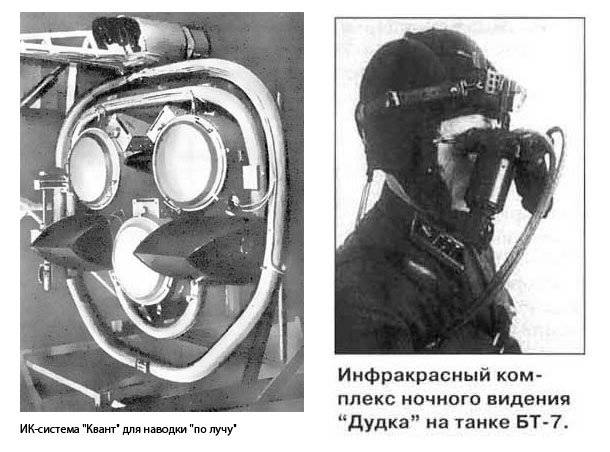
The first attempts to apply IR rays in practice belong to the second half of the thirties. In 1938, tests of the homing planning torpedo (PT) began. This ammunition had to be dropped from a TB-3 or similar in size and payload, and then independently search for a target. To ensure targeting, the aircraft was equipped with the Kvant complex. In the fuselage of the test aircraft TB-3 placed the equipment of the complex, and in the nose part was mounted platform target designator. Three infrared illuminators were installed on the guided frame swinging in two planes. It was assumed that the system operator will keep their rays on the target, and the torpedo will be induced on the reflected radiation. Preliminary tests of the Kvant system showed its principal performance. However, the absence of a modern carrier intervened. Due to the equipment installed on the aircraft, the TB-3 bomber lost approximately 4-5% of its maximum speed, which was particularly noticeable with its flight data. Also, complaints were caused by the size and weight of the aircraft part of the Kvant complex. It was recommended not to hurry up to a certain time with the adoption of "Quantum" and the PT for service and bring the system to mind. Over time, instead of TB-3, it was planned to use the TB-7 (Pe-8) bomber as a carrier. However, 19 July 1940, the project to develop planning torpedoes and all related equipment was minimized. All the organizations participating in it were “transferred” to other, more relevant areas.
Simultaneously with the start of testing of the Kvant complex, the staff of the All-Russian Electrotechnical Institute Lenin presented a finished prototype of a night vision device. The development of the laboratory of V. Arkhangelsky was based on an electron-optical converter. This converter had a photocathode and a luminescent screen. Infrared light reflected from surrounding objects was necessary for operation of the device. It should be noted that such a system is still used, although it has to compete with other types of night vision devices.
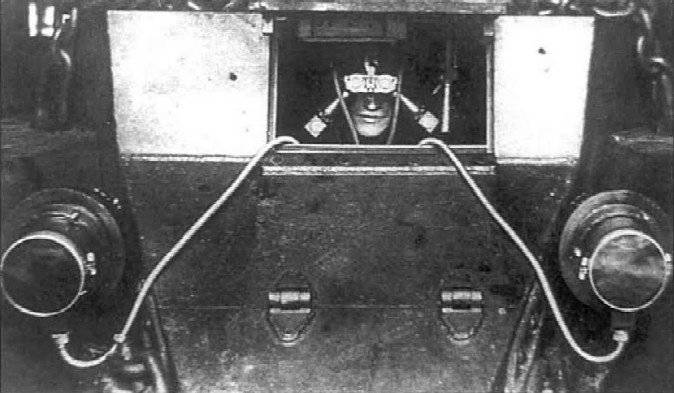
At first, in 1937, a prototype of a night vision device and an infrared illuminator were tested at the training ground for tank BT-7. Despite a number of shortcomings and a generally crude design, the device arranged for the military. The People’s Commissariat of Defense recommended continuing to fine-tune the NVD itself, and the searchlight for it was allowed to run in series. In 1939, two sets of equipment for night driving were immediately sent to the training ground of the Research Institute of Armored vehicles. These were the "Ship" and "Pipe" systems. The basis of the Ship complex was periscopic glasses for the tank crew, which in combination with infrared illumination provided the possibility of action in low light conditions. The complex “Pipe” in its ideology was similar to “Shipu”, but had the best characteristics. Thanks to the use of two infrared spotlights with a power of one kilowatt each at once, and also due to the new version of the Dudka image intensifier, it allowed to see objects located at a distance of about 50 meters. Naturally, in combat there was almost no benefit from such systems - 50 meters is clearly not the distance of a tank battle. Nevertheless, the military saw in Shipa and Dudka an excellent means of facilitating the movement of troops in difficult conditions. The People’s Commissariat of Defense ordered to continue improving night vision devices and begin preparing production facilities for their serial production.
Simultaneously with the testing of the system for the BT-7 tanks, VEI staff developed night-vision devices for ships. The dimensions of the watercraft made it possible not to squeeze the dimensions of the equipment until all qualities were lost, therefore, in the same 37, we managed to make a prototype of a system with a range of about 500 meters. Again, infrared spotlights and photoelectronics did not allow them to be used in combat. But the IR rays are excellent for ship navigation. Began small-scale production of ship infrared systems.
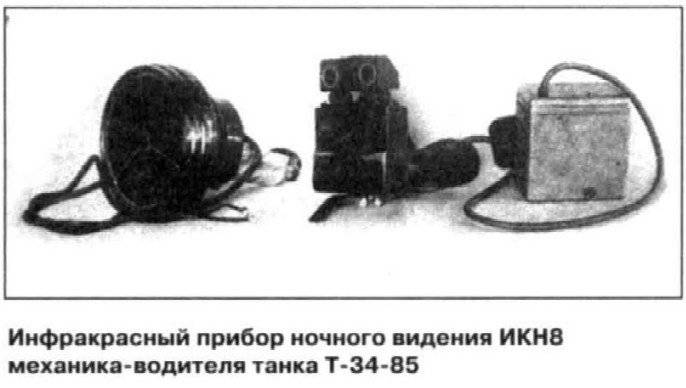
The outbreak of World War II had a bad effect on the entire country, including VEI. The loss of many production capacities at first did not allow to launch full-scale serial production, and then there were regular problems with the development of new designs. Nevertheless, by the beginning of the war, only the Black Sea Fleet had 15 sets of night vision ship systems. By mid-autumn, Black Sea sailors will receive another 18. Already at the very beginning of the Black Sea war navy noticed one interesting thing: when using infrared navigation lights, the Germans did not see them and did not start shelling the fairway. Therefore, first the entrance to the port of Sevastopol was transferred to the new system, and then at the first opportunity other ports of the Black Sea were equipped with infrared lights. By 1943, the entire Black Sea Fleet was equipped with Omega-VEI direction-finding systems and Gamma-VEI binoculars. Thanks to the full equipping of new equipment in the same year, infrared illumination became the main means of guarding fairways.
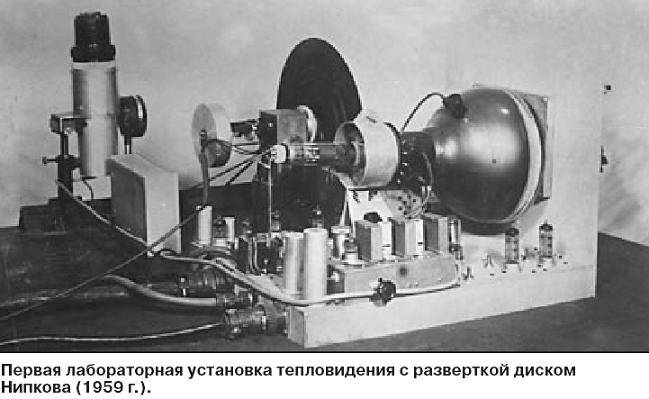
In the same 43rd year, infrared technology returned to Aviation. Field tests took place all year, and in December several Gamma-VEI binoculars were sent to the Smolensk region. It quickly became clear that they are not fully suitable for providing visual reconnaissance from the air. But the infrared equipment was again useful for navigation. Using the Gamma-VEI binoculars, an airplane equipped with an infrared spotlight was visible from a distance of up to 40 kilometers. In turn, the pilots could see landing signs illuminated by infrared radiation at distances up to 4-5 km.
In the middle of 1944, tests of infrared observation instruments for the T-34 tank were started. The first was brought night vision device TSC-8, designed for a driver mechanic. With the device for the commander and the gunner, the work went harder - the peculiarities of their placement inside the armored vehicle had an effect. Therefore, the first vehicles with tolerable characteristics not only for the driver appeared only after the war.
In the autumn of 43, employees of the All-Russian Electrotechnical Institute based on Gamma-VEI binoculars made a night sight for a rifle weapons. For obvious reasons, it was not possible to equip it with a searchlight illumination. However, when using an external source of IR radiation, the system worked well. Claims again caused a small range - even at the end of the war, for the best prototypes, this figure did not exceed 150-200 meters.
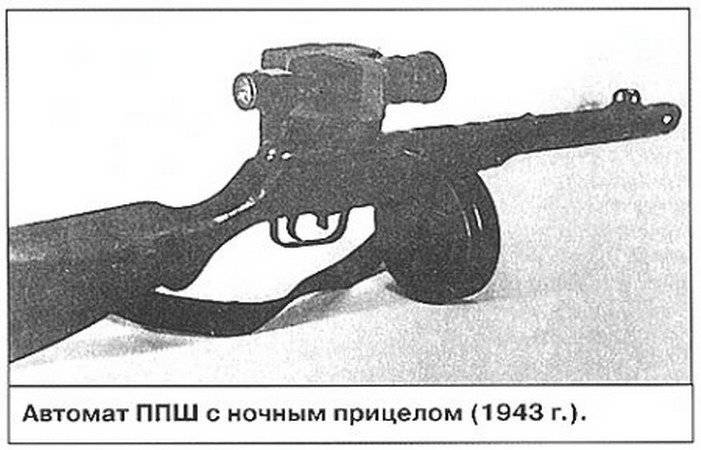
At the end of the Great Patriotic War, Soviet engineers and scientists were able to compare their developments and their German counterparts. As it turned out, the praised German equipment in its performance practically did not differ from the domestic one. And this is not surprising: before the war, both countries were in roughly equal technological conditions. Therefore, there were practically no qualitative differences between the developments. But there were quantitative. On the territory of Germany, the war came only in 45-m, so the Nazis did not need to evacuate enterprises, to start production or even rebuild factories from scratch. Probably, if it were not for these priorities, on the fronts the “Panthers” with infrared devices would have confronted the T-34 with no less sophisticated equipment.
On the materials of the sites:
http://russianengineering.narod.ru/
http://tsushima.su/
http://army-news.ru/
Information